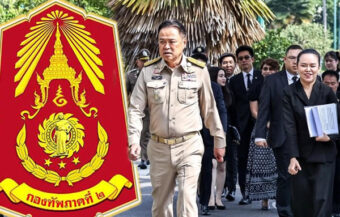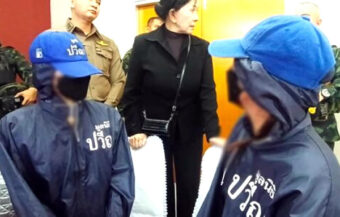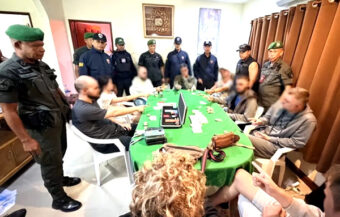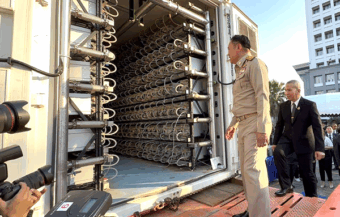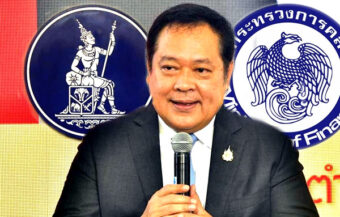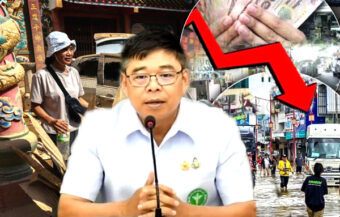Thailand is shifting to high-cost tourism, with hotel rates soaring and long-haul arrivals rising. European and North American visitors surge, while budget travel declines. Hoteliers resist discounts as the kingdom ends its low-cost image to focus on premium growth.
Thailand’s Tourism Minister appeared upbeat on Saturday as he reported a significant rebound in long-haul visitors to the kingdom in April, with Polish and Italian arrivals each rising by 30% year-on-year. This surge aligns with efforts by Thai hoteliers to maintain premium pricing, keeping rates among the highest in Southeast Asia. However, the kingdom still seems unlikely to match the tourist volumes or foreign revenue recorded in 2019. In effect, Thailand is now firmly pursuing a high-cost tourism model that emerged after the pandemic. It signals an end to the era of budget travel and low-cost accommodation that once defined it.

Minister of Tourism and Sports Surawong Thienthong on Saturday was more upbeat about Thailand’s tourism prospects. Earlier this week, he described the industry as in a state of ‘crisis’ as he and top officials blamed the foreign media for negative coverage of the kingdom. The turnaround followed a string of positive indicators and internal reassessments.
Industry insiders had urged calm, warning against knee-jerk reactions to short-term downturns.
Budget travellers vanish as hotel rates rise and Thailand turns to a high-cost tourism model post-COVID
One thing, however, is becoming clear: the heyday of the budget Western traveller visiting Thailand as a backpacker staying in a luxury hotel room for $29 to $45, as seen 20 years ago, is certainly over. Hotel rates have risen significantly since the pandemic, while average tourist spend per capita has declined.
Thailand has yet to recover the volume or revenue it saw in 2019. Despite this, the kingdom is pursuing a higher-cost tourism model. In recent months, it has seen arrivals from short-haul markets decline—down by 17%. Long-haul tourists, however, are coming back.
On Saturday, Mr Surawong, following a review of the industry with Prime Minister Paetongtarn Shinawatra, hailed an upward surge in long-distance travellers to Thailand. He pointed to rising bookings from Europe and North America, saying these markets were showing “renewed confidence” in Thailand.
April sees a dip in Asian arrivals but Chinese Golden Week brings a much-needed temporary rebound
Thailand’s tourism sector is navigating a mixed outlook, with signs of recovery tempered by regional slowdowns. In April, foreign arrivals fell by 7.6% year-on-year. This drop was driven primarily by a sharp decline in Chinese and broader Asian markets. Fewer travellers from these regions opted to visit, reflecting ongoing economic caution and reduced flight capacity.
However, during the Chinese Labour Day holiday, a sudden surge offered relief. According to the Tourism Minister, approximately 100,000 Chinese tourists arrived during the Golden Week break. This brief spike reversed earlier declines and was seen as a hopeful sign of a rebound from China.
Previously, arrivals from China had plummeted to just 5,000 per day — a fraction of pre-pandemic levels. As a result, Malaysia surpassed China in April to become Thailand’s top source of foreign visitors. China’s first-quarter arrivals stood at only 196,880, far behind Russia’s 429,254 tourists during the same period. India and the United Kingdom also moved ahead of China in late April.
Nevertheless, long-haul markets have shown strong momentum. These countries are increasingly vital for the tourism sector. For example, Polish arrivals jumped 32.78%, reaching 112,989 visitors. Italian numbers also rose sharply by 20.42%, with 121,252 travellers recorded. Meanwhile, Saudi Arabia sent 45,903 tourists — up by 12.44%.
European and North American markets surge as Thailand focuses on long-haul visitors to stabilise income
Importantly, these long-distance visitors tend to spend more. As such, they help offset the financial impact of reduced regional travel. Moreover, the Tourism Ministry now views these travellers as essential to Thailand’s future tourism model.
The upward trend continued with Canadian tourists. Arrivals from Canada reached 114,136 — a 9.51% increase. Similarly, Denmark contributed 79,013 tourists, rising by 10.18%. In response, Thai officials are actively branding these countries as “priority markets” for growth and stability.
So far in 2025, the kingdom has welcomed 12.21 million international arrivals. This is up to May 1st 2025. This performance suggests Thailand could match or even slightly exceed last year’s figures. However, the numbers still trail well behind the 39.8 million arrivals seen in 2019.
Even so, there is reason for optimism. While total arrivals are lower, tourism revenue is holding steady. In fact, earnings are tracking closely with government targets. This suggests the shift to a higher-value tourism model may be working.
Thailand’s new tourism strategy focuses on long-stay premium travellers amid regional competition pressure
Although short-haul markets remain soft, Thailand’s bet on premium, long-stay travellers appears to be paying off. Still, further growth will likely depend on improving flight connectivity, relaxing visa rules, and rebuilding confidence — especially among Asian travellers. With global tourism shifting, Thailand is racing to stay ahead.
During this time, tourists spent a combined ฿581 billion, averaging ฿47,584 per visitor, which is 4.8% behind the average spend in 2019. While spending per head is lower, officials hope targeted campaigns will lift high-value tourism segments.
Certainly, the reason for that is the shift in Thailand’s market post-pandemic towards Asia and short-haul foreign tourism. At the same time, there appears to be a movement back to Thailand for Western holidaymakers as the Chinese market recedes. Industry players have also warned against relying too heavily on regional markets given their volatility.
However, the problem may be that the kingdom now faces stiff competition from other Southeast Asian destinations, particularly Indonesia and Vietnam. Vietnam recently overtook Thailand in Chinese tourist arrivals, highlighting the growing rivalry.
Thailand abandons low-cost image as officials promise fairer pricing and support for upscale hoteliers
On Wednesday, Minister Surawong was quite definitive when he stated that Thailand was no longer aiming to be a cheap destination.
He made these remarks as he promised action on dual pricing. Nonetheless, he insisted that Thai tourism operators are determined to achieve the best market rates for their services, including hotels.
He also hinted at potential tax incentives to help hoteliers maintain quality without slashing rates.
This comes as Thailand’s leading upscale hotel establishments have reported a 10% rise in booking rates for the first three months of 2025. This increase occurred despite some public backlash over rising costs.
Thienprasit Chaiphatranant, the President of the Thai Hotels Association (THA), quoted the average room rate in March 2025 at $157. Notably, this is higher than the achieved rate. It certainly reflects expectations for higher-end guest accommodation, including four-star and five-star hotels. The rate marks an 8% year-on-year increase, signalling resilience in the upper-tier hotel segment.
Luxury hotel rates soar in Bangkok and Phuket as Thailand reaffirms premium strategy over price cuts
Of course, the quoted rates for top hotels vary. A four-star hotel in the heart of Bangkok offers rates ranging from $59 to $193, depending on the room type.
Certainly, even rooms at Bangkok’s most prestigious addresses can be had for as little as $120 or ฿3,600. However, rates can rise to as much as ฿75,000 for suites and exclusive accommodation. In contrast, Vietnam averaged $129 for March 2025, underlining further Thailand’s premium pricing stance.
Nevertheless, on Saturday, Mr. Suksit Suvunditkul, the President of the Southern Thai Hotels Association (THA), quoted even higher figures for Phuket.
For instance, he said rooms at five-star levels were commanding rates of ฿10,000 per night, with four-star accommodation priced between ฿6,000 and ฿7,000. In the meantime, villas can cost as much as ฿20,000 to ฿30,000 per night.
Mr. Suksit acknowledged that these rates were higher than those in Bangkok.
Thai hotels resist discounting as higher costs push rates beyond regional rivals during peak seasons
“It’s true that we set more expensive prices,” he said. “After five-star and luxury hotels led the way in raising their rates above pre-pandemic levels in the 2023–2024 high season, four-star hotels took the opportunity to follow suit in the recently concluded high season.” He added that Phuket’s minimum wage hit ฿400 this year, fuelling overall cost inflation.
Meanwhile, rates across Thailand, and indeed in Bangkok, have risen significantly from 2019 when the average rate was ฿1,920 per room. Presently, this is being quoted at ฿4,300 or $128 per room. The rise places Thailand among the top three most expensive markets in Southeast Asia during the high season.
However, during the low season, Thailand slips to third place, with rates hovering around $100, behind Singapore and Indonesia.
In short, the Thai hotel industry appears to be holding its rates or even increasing them in the face of lower demand. Lower demand means hoteliers compete for falling visitor numbers. Right now, most operators are resisting deep discounts, fearing damaging long-term price wars.
Hoteliers aim for quality over volume as occupancy rises. Prices up driven by labour and energy expenses
Hotel operators at the same time are struggling with rising staff costs and electricity costs. It is no longer feasible to return to previous pricing levels, they claim.
In March, top-level hotels recorded a 72% occupancy rate, compared to 69% last year. Notably, the luxury segment held firm outperforming Vietnam’s 61%. Therefore, with a renewed surge in European and Western long-haul travellers, this strategy might pay off.
TM6 goes off well but officials and Tourism Minister warn of industry in ‘crisis.’ Blame foreign media
Police Chief says new TM6 online will boost security in Thailand for good tourists and make it far safer
Thailand flies high after US aviation agency gives it Category 1 safety status. Airline and tourism boost
At the same time, in Vietnam, despite lower prices, the average occupancy rate in 2024 was 55%. Even with significantly more tourists than previously, the country only recorded an occupancy rate of 60% in the first quarter. This highlights that cheap pricing alone doesn’t guarantee strong occupancy or spending.
Finally, Mr. Suksit the southern boss of the Thai Hotels Association (THA) stressed that Phuket’s tourism model must shift away from volume. The island’s infrastructure caps foreign arrivals at 14 million. Indeed, last year’s 13 million already strained resources.
He said the island now targets a quality-over-quantity approach, attracting diverse markets rather than relying on any single country.
Join the Thai News forum, follow Thai Examiner on Facebook here
Receive all our stories as they come out on Telegram here
Follow Thai Examiner here
Further reading:
Thaksin does not rule out joining talks in US as Thai team finalises plans. They fly out on Thursday
Trump’s remaking of World trade, if it works, will force Thailand to decide between the US and China
US offers a 90-day tariff pause but Thailand must move faster as it already faces shaved GDP in 2025
PM addresses the nation in shock over last week’s earthquake and this week’s Trump tariff bombshell


